
As a profession, now more than ever, it is vital that we advocate the services that libraries can offer and the real difference that they can make to their communities.
If you or your library team ran a successful campaign last year to market all or part of your service, now is your time to shout about it! Submit your entry to CILIP’s annual Marketing Excellence Awards and be rewarded for your hard work.
The Awards are open to any library of any size in any sector across the UK. You will be judged on your campaign’s impact, effectiveness and creativity, not your budget. From print or online collection promotions to storytelling projects, new services or events programmes to the launch of major new library buildings, the Marketing Excellence Awards exist to celebrate achievement at whatever scale it may be.
You've done the hard work, delivering your project. Now win some extra recognition.
Why enter?
The Marketing Excellence Awards celebrate successful library marketing and promotional campaigns across the country. They can offer national exposure for your project and help communicate the value of what you're doing among funders, partners, media, peers, managers and customers.
Judging
Entries are judged by the Publicity and Public Relations Group Committee, one of CILIP’s Special Interest Groups. This year the panel are delighted to be joined by Committee members from both the Academic and Research Libraries Group and the Public and Mobile Libraries Group to provide additional expert external validation.
Judging will be against a number of criteria:
- Success in meeting the original aims and objectives of the campaign
- Suitability of concept to target market
- Quality of graphics, design and copywriting (where appropriate)
- Range, effectiveness and appropriateness of the marketing communications used
- Timing, message and consistency of marketing communications
- Evaluation of campaign, demonstrating evidence of impact on the community or target audience (e.g. customer interaction, feedback, attendance, media coverage)
- Effective use of project budget and non-financial resources














